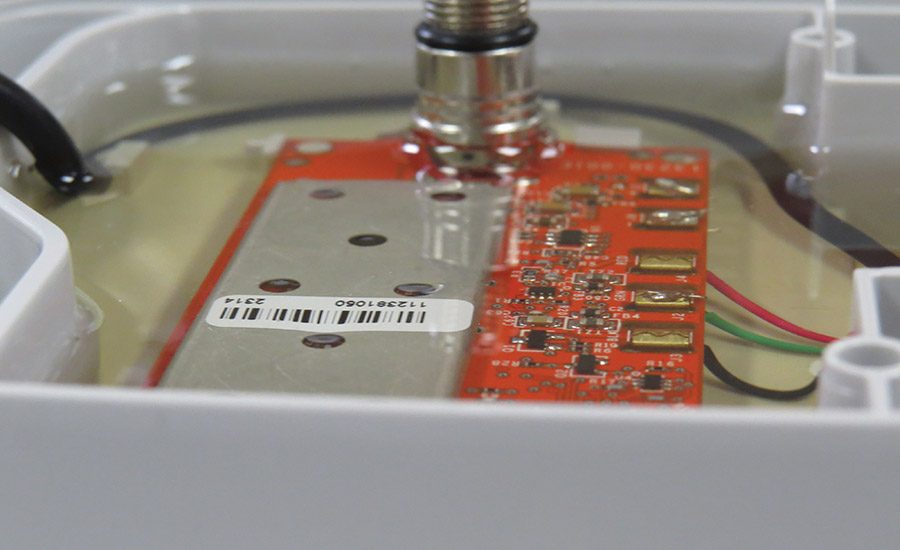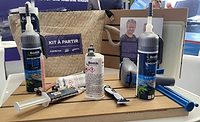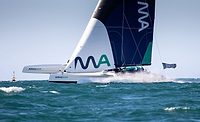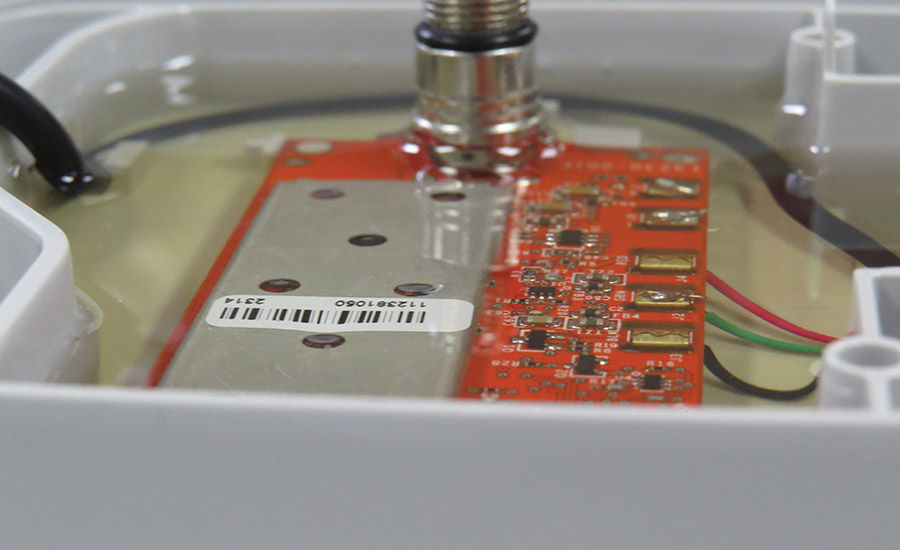Marine Applications for Adhesives and Sealants
Today’s marine adhesives and sealants provide strong lightweight bonds to structural components and watertight sealing between substrates.


Electronics potted in a clear epoxy resin that was selected for its ability to insulate electronics from risk while still maintaining a transparent medium. In this case, the barcode is visible and can be scanned directly through the cured epoxy.


Adhesives and sealants have a long history in shipbuilding and marine industries, providing protection against water, chemicals, weather, and environmental degradation. In the earliest days of seafaring, natural sealants such as pine resins were cooked down and applied liberally, requiring regular re-treatments. Later, manmade derivatives such as “pitch” (a tar-like substance created from petroleum, coal tar, or some plants) proved to be more resilient.
Today’s products have come a long way, no longer representing the extreme hazards of resin or pitch while providing strong lightweight bonds to structural components and watertight sealing between substrates. The improved structural bonding capabilities support the use of lightweight one-piece composite hulls while reducing construction time and generally improving aesthetics. Durability, flexibility, and longevity of bonded parts are also improved with the use of adhesives; modern formulas exhibit improved UV and chemical resistance, as well as noise and vibration dampening.
Adhesive and Sealant Chemistries
By far, the largest portion of adhesives used in manufacturing watercraft are methyl methacrylates (MMAs). These two-component structural adhesives are used in the primary bonding application of the marine industry: bonding the hull to the boat frame. Prior to applying the adhesive, a tracing of the frame is painted inside the hull. The tracing is then outlined in MMA adhesive from industrial-scale dispensing guns. The bead size for this application can range up 2 in., so significant volumes of adhesive are utilized by manufacturers in this application.
This job was once done with epoxies, but surface preparation requirements and long cure times left manufacturers looking for a more efficient process. MMAs are slightly more expensive than epoxies with similar bonding properties, but the cost savings in simplifying the process more than make up the difference.
When using epoxies, manufacturers were required to prepare the bonding surface by sanding the composite hull. Switching to MMAs allowed manufacturers to eliminate this step. When combined with a significantly reduced cure time, which in turn helps manufacturers increase throughput per hull mold, the switch to MMAs becomes a clear choice. The latest developments in MMAs have come from improvements in impact resistance, which is a key factor for structural bonding in the marine industry due to the incessant impacts with water and wave formations.
Other common adhesive/sealant types include polyurethanes, polysulfides, polyether, and silicone-based products such as caulk. Each type of marine sealants has its own characteristics that make it useful for a significant task. It is crucial to understand the physical properties of each sealant in order to select the right one for each application.
Adhesives and sealants are measured on key physical properties such as the ability to stick to a substrate, the resistance of a bond to breaking under tension, or its resistance to chemical exposure. These properties play into key placement decisions. Some sealants can be used with plastics and will not attack or damage the plastic material, others tolerate fuel exposure, and still others can be used below the waterline under pressure and long-term exposure to saltwater.
Various chemistries in marine applications include silicones, epoxy adhesives, moisture-cure polyurethanes, acrylates, anaerobic adhesives, polysulfide sealants, and several others. Each has a role to play in specific marine applications.
Window Bonding
For bonding/sealing windows, sealants must provide a strong and elastic bond that ensures water tightness and is flexible enough to absorb some movement and impact shock. Silicone sealants are recommended for this application due to their fast cure, flexibility, chemical resistance, and ability to bond well to smooth surfaces. They offer outstanding elasticity and resist mold, mildew, UV, heat, weathering, and chemical attacks from both oil and cleaning solvents.
Silicone is not as strong as polyurethane and polysulfide, but it offers a key advantage in that it is compatible with plastic. As curing agents, silicones use different chemicals, leading to different physical properties of the cured material.
A downside of using a silicone sealant is that it leaves behind a residue that is difficult to remove. Neither fresh silicone nor any paint can adhere over the residue, so additional cleaning is required to remove the residue. Another weakness is that it can be pulled apart easily. On boats, silicones show excellent performance for sealing windshield glass, metal trim, and electrical insulation. They are not paintable or sand-able, as they are too soft and will shred and peel.
Deck Hatch Sealing
One of the most important water access points of a boat is the hatch. A failed seal on a hatch can result in damage to a boat over time from mold and the degradation of internal materials and joints.
For private boats, most designs offer one or two main hatches. The main hatch is more important than most other seals simply due to the size of the opening. The main hatch or hatches are usually the largest opening to below deck.
Sealing the deck hatch starts with surface prep, wiping down the mating surfaces. The deck hatch sealant must be resistant to water, UV exposure, and temperature extremes/thermal cycling. Silicone sealants that cure to a flexible and durable silicone rubber at room temperature are very popular for deck hatch applications.
Motors and Diesel Exhaust Fluid
One less-discussed area of marine adhesives and sealants involves applications in the diesel engine motors and fuel/diesel exhaust fluid (DEF) lines feeding the motor. Motors are often considered a single component since they come prefabricated and only require installation. However, whether it is sealing threaded fittings, retaining shaft and collar assemblies, or locking threaded assemblies in place to resist loosening under the constant vibration of the motor, adhesives and sealants play a key role in maintaining a functional and efficient motor.
The manufacturing and maintenance teams servicing these motors require threadlockers, oil shaft seals, and sealants to secure piping of DEF. Large marinas also have diesel fuel pumps and diesel exhaust fluid pumps to refill DEF reservoirs. These pumps are notoriously difficult to seal and need a specialized thread sealant to stop leakage.
Competition in the marine market is tough, particularly today since the purchase of luxury items such as boats has dried up due to the uncertainty of COVID-19. Manufacturers of diesel motors and those installing motors with threaded mounting assemblies that are looking to reduce materials costs for threadlockers or retaining compounds can improve their bottom line by switching to alternative threadlocking brands.
Sealing Electronics
Water damage and impact damage are the highest dangers for electronics in marine environments. To mitigate the risk, electronics need to be sealed and buffered with an impact- and water-resistant sealant. This often takes the form of potting the electronics casing (where a cavity is entirely filled with a sealant) or encapsulating the sensitive part (encasing the electronics in a covering of sealant).
Epoxies are commonly recommended for protecting electronics in these ways. Epoxy compounds create a physical barrier to protect sensitive components from water, corrosion, vibration, and shock.
Epoxies adhere well to many materials and can be a good fit when considering a permanent and semi-flexible bond. These materials come in one- and two-part formulations that often involve a mixing step to prepare for application. Epoxies are relatively low cost and cure to a smooth, hard, and often clear material. The low cost makes them the preferred choice for large-scale applications whenever sealant characteristics permit.
Below the Waterline
In order to avoid degradation over time, sealants that do not absorb water are selected when sealing below the waterline. Polyurethanes can be used below the waterline due to their outstanding resistance to weathering, UV, and saltwater.
Polyurethane sealants create powerful adhesive bonds due to their high tensile strength, and they are not easy to pull apart if they need to be disassembled. For this reason, polyurethanes work well in deck bonding applications and joints by offering a strong and permanent bonding strength. They are excellent on wood-to-wood bonding and deck-to-hull joints, where they cure at a medium rate.
However, the use of wood in modern marine manufacturing has gone the way of the dodo bird. Most marine manufacturers today use exclusively composite materials. Many even compete to show that they do not include any wood in their design while exhibiting the quality of their composite materials.
With the rise of fast-curing, impact-resist MMAs providing a firm bond that give end users a solid, well-built and stable feeling on deck, there is no reason to look back. But even now, standard MMAs are old news. The wheels of progress grind on, and no one can afford to be left behind. Marine manufacturers looking to give customers confidence in their construction should explore the latest advancements in MMA formulas offering increased impact resistance.
Reliable Partners
Whether utilizing MMAs, silicone sealants, thread sealants, epoxies, or others, marine manufacturers will always need a reliable and flexible source for their adhesives and sealants. Just as an adhesive bond needs to flex to meet the requirements of the application, manufacturers need to flex to meet their customers’ needs.
For more information, visit www.hernon.com.
Looking for a reprint of this article?
From high-res PDFs to custom plaques, order your copy today!









